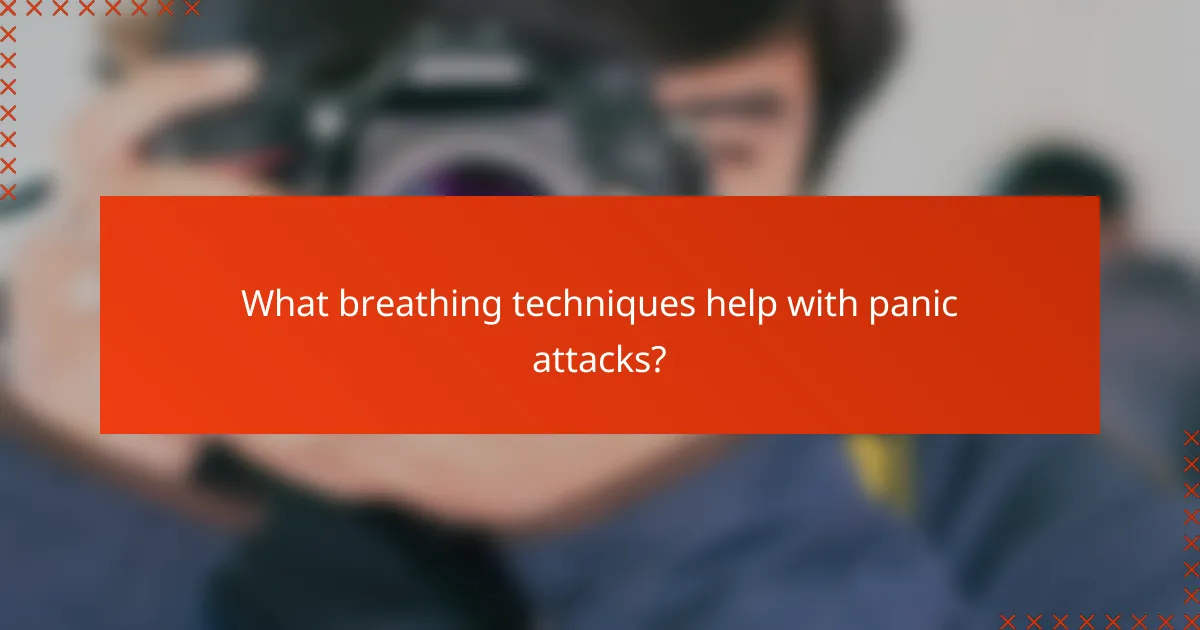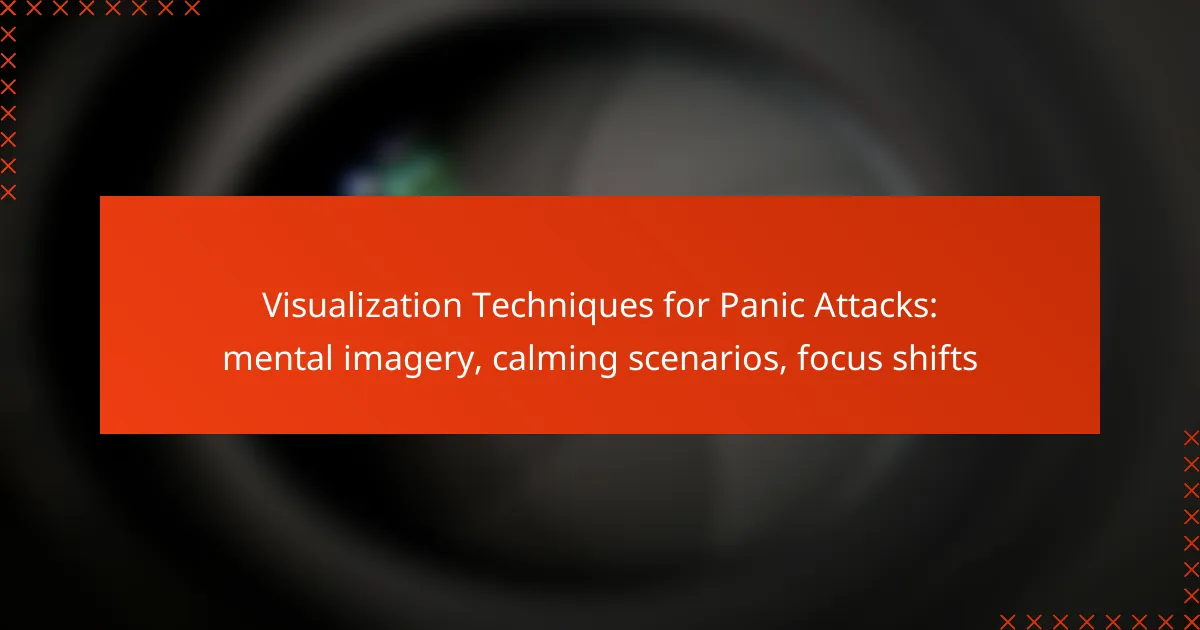Panic attacks can be overwhelming, but breathing techniques offer effective ways to regain control and promote calmness. By practicing deep breathing, controlled pace breathing, and relaxation response methods, individuals can counteract the physiological symptoms of panic and reduce anxiety. These techniques focus on regulating breath to enhance oxygen flow and activate the body’s natural relaxation mechanisms.

What breathing techniques help with panic attacks?
Breathing techniques that help with panic attacks focus on regulating breath to promote calmness and reduce anxiety. Effective methods include deep breathing exercises, controlled pace breathing, and relaxation response methods, each designed to counteract the physiological symptoms of panic.
Deep breathing exercises
Deep breathing exercises involve taking slow, deep breaths to increase oxygen flow and activate the body’s relaxation response. To practice, inhale deeply through your nose for a count of four, hold for a count of four, and exhale slowly through your mouth for a count of six. Repeat this cycle several times until you feel more centered.
Consider using a visual aid, such as a breathing ball or a simple app, to help maintain your rhythm. Aim for a few minutes of deep breathing, especially during the onset of a panic attack, to help regain control.
Controlled pace breathing
Controlled pace breathing emphasizes maintaining a consistent rhythm while breathing, which can help stabilize heart rate and reduce feelings of panic. A common technique is the 4-7-8 method: inhale for four seconds, hold for seven seconds, and exhale for eight seconds. This method can be practiced anywhere and is effective in calming the nervous system.
It’s beneficial to practice controlled pace breathing regularly, even when not feeling anxious, to build familiarity. Start with a few cycles and gradually increase the duration as you become more comfortable.
Relaxation response methods
Relaxation response methods combine breathing techniques with mental focus to reduce stress and anxiety. Techniques such as progressive muscle relaxation, where you tense and then relax different muscle groups while focusing on your breath, can be particularly effective during panic attacks.
Incorporate visualization by imagining a peaceful scene while practicing these methods. Aim to dedicate 10-20 minutes daily to these practices, which can help create a lasting sense of calm and resilience against panic attacks.

How does deep breathing alleviate panic attacks?
Deep breathing helps alleviate panic attacks by slowing the heart rate and reducing the body’s stress response. This technique encourages a state of calm by increasing oxygen flow and activating the relaxation response.
Reduces anxiety symptoms
Deep breathing can significantly reduce anxiety symptoms during a panic attack. By focusing on slow, controlled breaths, individuals can interrupt the cycle of hyperventilation and racing thoughts that often accompany anxiety. This method helps lower cortisol levels, which are associated with stress.
Practicing deep breathing techniques can be done anywhere, making it a practical tool for managing anxiety in various situations. For example, inhaling deeply for a count of four, holding for four, and exhaling for four can help ground a person experiencing a panic attack.
Promotes relaxation
Deep breathing promotes relaxation by engaging the parasympathetic nervous system, which counteracts the fight-or-flight response. This shift leads to a decrease in muscle tension and a sense of calm. Regular practice can enhance overall well-being and resilience against stress.
To maximize relaxation, find a quiet space and focus on your breath. Consider using visualization techniques, such as imagining a peaceful scene, while breathing deeply. Aim for sessions of five to ten minutes, several times a day, to build a habit that supports long-term relaxation.

What is controlled pace breathing?
Controlled pace breathing is a technique that involves regulating your breath to promote calmness and reduce anxiety. By consciously managing the speed and depth of your breathing, you can activate your body’s relaxation response, which helps alleviate symptoms of panic attacks.
Structured breathing rhythm
A structured breathing rhythm typically involves inhaling for a specific count, holding the breath, and then exhaling for an equal count. For example, you might inhale for four seconds, hold for four seconds, and exhale for four seconds. This method creates a predictable pattern that can help stabilize your heart rate and reduce feelings of panic.
To practice, find a quiet space and sit comfortably. Focus on your breath, counting each phase to maintain the rhythm. Gradually, you can adjust the counts to find a pace that feels most comfortable for you, such as extending the exhale to six seconds for a deeper relaxation effect.
Enhances focus during anxiety
Controlled pace breathing enhances focus during anxiety by redirecting your attention from distressing thoughts to the act of breathing itself. This shift in focus can break the cycle of panic and help ground you in the present moment.
When feeling anxious, try to concentrate solely on your breath. Notice the sensations of air entering and leaving your body. This mindfulness practice can help reduce racing thoughts and create a sense of calm, making it easier to manage anxiety in challenging situations.

How can the relaxation response be triggered?
The relaxation response can be triggered through techniques that promote deep breathing and a controlled pace, helping to counteract the body’s stress response. This physiological state reduces tension and enhances overall well-being, making it effective during panic attacks.
Mindfulness meditation
Mindfulness meditation involves focusing on the present moment, which can help activate the relaxation response. By concentrating on your breath and observing thoughts without judgment, you can create a sense of calm and reduce anxiety. Aim for sessions lasting 5 to 20 minutes, depending on your comfort level.
To practice, find a quiet space, sit comfortably, and close your eyes. Inhale deeply through your nose, hold for a moment, and exhale slowly through your mouth. Repeat this process while gently bringing your attention back to your breath whenever distractions arise.
Progressive muscle relaxation
Progressive muscle relaxation (PMR) is a technique that involves tensing and then relaxing different muscle groups in the body. This method helps to identify and release physical tension, which can trigger the relaxation response. Sessions typically last between 10 to 30 minutes.
To perform PMR, start at your feet and work your way up to your head. Tense each muscle group for about five seconds, then relax for 30 seconds, noticing the difference in sensation. This practice not only calms the body but also promotes mental clarity and reduces stress levels.

What are the benefits of these techniques in the UK?
Breathing techniques for panic attacks offer significant benefits in the UK, including accessible mental health support and improved coping strategies. These methods can help individuals manage anxiety symptoms effectively and promote a sense of calm during stressful situations.
Accessible mental health support
In the UK, breathing techniques are often integrated into mental health support services, making them easily available to those in need. Many therapists and counselors incorporate these methods into their practice, providing clients with practical tools to manage panic attacks.
Additionally, various online resources and community programs offer workshops on breathing techniques, ensuring that individuals can access support regardless of their location. This accessibility encourages more people to seek help and learn effective strategies for managing anxiety.
Improved coping strategies
Breathing techniques enhance coping strategies by teaching individuals how to control their physiological responses during panic attacks. Techniques such as deep breathing and paced breathing can help lower heart rates and reduce feelings of panic, allowing for a quicker return to a state of calm.
Practicing these techniques regularly can lead to long-term benefits, such as increased resilience to stress and improved emotional regulation. Individuals are encouraged to set aside a few minutes daily to practice these methods, making them a valuable addition to their overall mental health toolkit.

What are prerequisites for effective breathing techniques?
To effectively use breathing techniques during panic attacks, individuals should first understand their panic triggers and create a calm environment. These foundational steps help in maximizing the benefits of deep breathing and controlled pacing.
Understanding panic triggers
Panic triggers can vary widely among individuals and may include stressful situations, certain environments, or even specific thoughts. Identifying these triggers is crucial, as it allows individuals to prepare and implement breathing techniques when they are most needed.
Common triggers might involve crowded places, public speaking, or financial worries. Keeping a journal to track these triggers can help in recognizing patterns and developing tailored strategies for managing them.
Creating a calm environment
A calm environment is essential for practicing effective breathing techniques. This can involve finding a quiet space, reducing distractions, and ensuring comfortable seating or lying positions. Soft lighting and soothing sounds can further enhance relaxation.
Consider using calming scents, such as lavender or chamomile, which may help in creating a more serene atmosphere. Establishing a routine for practicing breathing techniques in this environment can reinforce relaxation responses and improve overall effectiveness during panic episodes.



